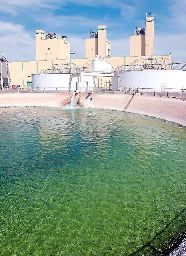
Xcel conserves with effluent: Amarillo sewage water helps produce energy
 |
|
Second Time Around: Treated wastewater
pours into a holding lagoon at the Nichols and Harrington power plants.
Xcel uses 5 billion gallons of wastewater a year in the powerplant
cooling system.
|
The two entities joined forces almost 45 years ago on a project that ships
sewage water from the River Road wastewater plant to the Nichols Station power
plant, where it is utilized to help produce power there and at Harrington
Station.
As fresh water supplies are becoming limited and demand is increasing, Xcel
Energy officials are being sought out to share their technology and expertise
with other industries and other cities.
Production of electricity at power plants requires a lot of water, but every
year Xcel Energy substitutes about 5 billion gallons of specially treated
Amarillo and Lubbock sewage water to power its three stations, said Bill
Crenshaw, Xcel spokesman.
'There's a great concern in this region about the long-term sustainability of
our water," Crenshaw said. "We've been working for decades to maintain
those long-term supplies."
Nichols Station laboratory supervisor Bernie Wieck, who oversees chemical
treatment of the effluent so it can be used at the plants, said substituting the
sewage effluent at the plants conserves enough fresh water to supply the yearly
needs of 100,000 people.
And Wieck said they can purchase the effluent for 16 cents per 1,000 gallons,
compared to 82 cents per 1,000 gallons if it was purchased as fresh water from
the Canadian River Municipal Water Authority or $1.25 per 1,000 gallons from the
city of Amarillo's well fields, which is only used in emergency cases.
Dan Coffey, city of Amarillo director of utilities, said the city started
selling effluent in the mid-1950s to the Texaco refinery, but in 1959, the city
built its first pipeline to Nichols Station.
Today, Coffey said, the city sells most of the water treated at the River
Road plant, the city's largest waste water plant, to Xcel.
"Otherwise we would be discharging the water into the creek,"
Coffey said. "It's a water-conservation issue. SPS would have had to gotten
water for their cooling towers from wells or another source. This way you are
using the water for a beneficial purpose."
He said when Amarillo started selling its effluent, it was truly a leader.
"We've had other cities come to us about how we set it up, the treatment
and the technical issues involved," Coffey said.
"There are more and more cities trying to use their effluent," he
said. "It's becoming a more valuable commodity as demand for water in the
world increases. The availability of fresh water is limited and the demand is
greater, and reclaimed water is a good application for cities in certain
situations."
For Xcel, which provides electricity to 1 million people in a
52,000-square-mile region - a process that requires almost 350 million gallons
of water daily - it's a good application.
Nichols power plant design engineers, production personnel and
environmentalists have pioneered chemical treatment and other technologies over
the years that allow more and more re-use of the reclaimed sewage water,
Crenshaw said.
A major step was utilizing lime to remove phosphates from the water, which
had created a scaling problem at the Texaco plant, Wieck said. After
experimenting with amounts, it was determined 1.5 pounds of lime per 1,000
gallons of treated water was needed.
When water comes from the River Road facility, it is put into clarifiers
where lime is added and then it goes into a settling zone and into the makeup
lagoons, he said.
Approximately 350 million gallons of water a day are circulated through all
the towers. About 8 million gallons are lost daily to evaporation and another 3
million is sent to irrigation, so the missing 11 million gallons is resupplied
daily from the makeup lagoons or effluent water, Wieck said.
The water can be circulated hundreds of times as cooling-tower water and when
it is no longer usable for that purpose because of high salt content, much of it
can be further recycled as irrigation water for nearby grass pastures, he said.